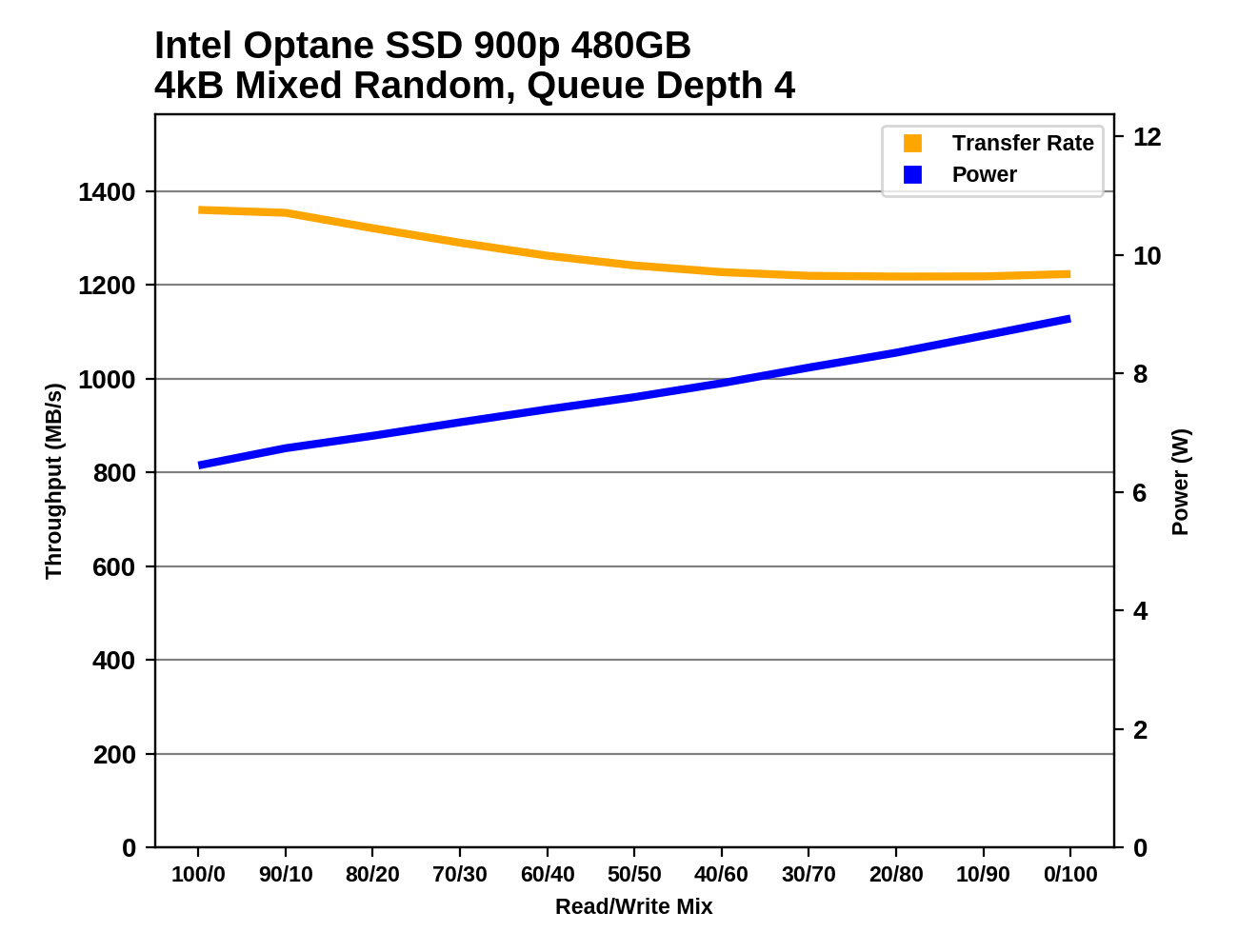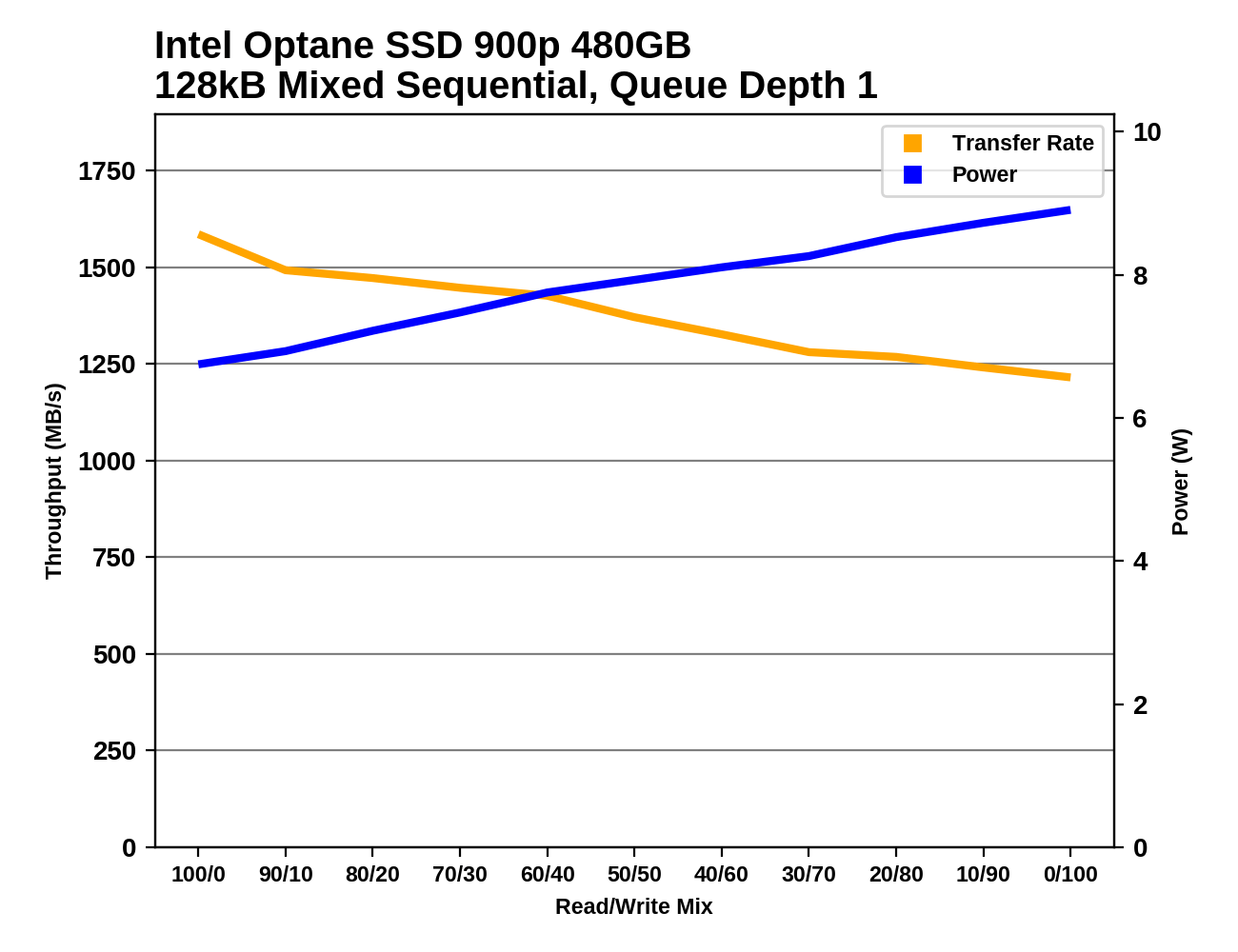The Intel Optane SSD 900p 480GB Review: Diving Deeper Into 3D XPoint
by Billy Tallis on December 15, 2017 12:15 PM ESTMixed Random Performance
Our test of mixed random reads and writes covers mixes varying from pure reads to pure writes at 10% increments. Each mix is tested for up to 1 minute or 32GB of data transferred. The test is conducted with a queue depth of 4, and is limited to a 64GB span of the drive. In between each mix, the drive is given idle time of up to one minute so that the overall duty cycle is 50%.

Since this mixed random I/O test is conducted at the relatively low queue depth of four, the Optane SSDs have a large performance advantage, and even the tiny Optane Memory M.2 does well (though it has to run a slightly modified version of the test due to its low capacity). The Optane SSDs are more than three times faster overall than the highest-scoring flash-based SSD.

The Optane SSDs have a substantial power efficiency lead on the mixed random I/O test, but it is small enough that flash-based SSDs could conceivably catch up with a generation or two of improvements. As usual, the 480GB model has clearly lower efficiency because its minor performance advantage doesn't outweigh the power cost the extra 3D XPoint memory chips.
 |
|||||||||
Both capacities of the Intel Optane SSD 900p show a modest decline in performance as the workload becomes more write-heavy, and a fairly linear increase in power consumption. The 480GB model's power consumption grows slightly faster than the 280GB model, leading to a 0.9W gap at the end of the test.
Even the Intel SSD 750 draws substantially less power for most of the test, though it catches up at the very end. The flash-based M.2 NVMe SSDs are mostly drawing a fraction of what the Optane SSDs require. In terms of performance, none of the flash-based SSDs come at all close to the Optane SSDs until the very end of the test, where many are able to deliver good random write speed.
Mixed Sequential Performance
Our test of mixed sequential reads and writes differs from the mixed random I/O test by performing 128kB sequential accesses rather than 4kB accesses at random locations, and the sequential test is conducted at queue depth 1. The range of mixes tested is the same, and the timing and limits on data transfers are also the same as above.

The Intel Optane SSD 900p is much faster on the mixed sequential I/O test than any consumer flash-based SSD. Samsung's best drives are slower by a third, and it's downhill from there for NAND flash. The 480GB model actually performed slightly worse on this test than the 280GB model, but the difference is small enough it may simply be due to variation between runs.

The power efficiency of the Optane SSD 900p on the mixed sequential I/O test is good but not quite at the top of the charts. Instead, it is on par with the Samsung 960 EVO, which sacrificed a bit of efficiency to improve performance relative to the Samsung 950 PRO.
 |
|||||||||
The 280GB Optane SSD 900p was a bit faster than the 480GB overall but a bit less steady over the course of the test. The scaling of the Optane SSDs is quite similar to the results from the mixed random test: a gradual decline in performance as the proportion of writes increases, and a linear increase in power consumption. The overall performance level is significantly higher than for the random I/O test.
The flash-based SSDs can get much closer to competing with the Optane SSDs on this mixed sequential test than on the mixed random test. Several drives have sequential read speeds that approach that of the Optane SSDs, and a few have higher sequential write performance. But through the middle portions of the test, the flash-based SSDs all lose a lot of their performance for at least a few phases of the test, while the Optane SSD has no acute performance weakness.










69 Comments
View All Comments
Billy Tallis - Friday, December 15, 2017 - link
The ATSB tests are Windows-based, and the synthetic tests are on Linux with fio. I can't really create a RAM disk large enough to properly run the ATSB tests (at least not on this system), but I'll look into running the synthetic tests against a RAM disk.tuxRoller - Saturday, December 16, 2017 - link
Thanks so much for the response and clarification.I'll keep an eye out for that ramdisk comparison:)
Chaser - Friday, December 15, 2017 - link
In other words, if you are the enthusiast gamer person like many of the people that read this site, you're throwing money away buying this for your gaming system.jabber - Friday, December 15, 2017 - link
You are pretty much throwing away money investing in anything faster than a 850EVO in a gaming rig.eek2121 - Sunday, December 17, 2017 - link
Not really, as a gamer, you should not only be looking at performance, but at reliability as well. Ironically I say this NOT because the 8xx EVO is crap (my 840 evo still has 93% life left and that's despite being used as a system drive for many years), but because my 960 evo has had a metric ton of degradation in the 6 months I've owned it.Klimax - Sunday, December 17, 2017 - link
Only if one has few games. There's better solution: 16GB of RAM + large regular HDD (WD Black and similar, their sequential reads are very good). Only initial load will be noticeable. (Anytime after that, caching will take care of that)CheapSushi - Friday, December 15, 2017 - link
Umm, what? Optane would be the better drive in every single way for OS and general usage. If you were going to get ONE main drive, it should be Optane.ddriver - Friday, December 15, 2017 - link
Sure, but is 0.01% faster in real world performance worth being 300$ more expensive? If you are going with one main drive, you better get better capacity than performance you can't make any use of.tricomp - Saturday, December 16, 2017 - link
Here is what Tom wrote about Optane OS drive : "You will see and feel a performance benefit just by using the Optane SSD 900P as your operating system drive. The feel of the system changes even if you’re replacing a high-performance NVMe SSD. You will notice the increased responsiveness immediately and then gradually become accustomed to it. In our experience, you will take the performance for granted until you work on a slower PC. Then you'll wish it had an Optane SSD." Its main advantage - 4K read performance - makes it OS kingeek2121 - Sunday, December 17, 2017 - link
"Tom" has been gone for a long time. Tom's hardware, much like AnandTech, has simply become a vehicle for Purch Ads (sadly). The AnandTech or Tom's Hardware of today have absolutely nothing to do with the original founders/sites. I don't mean to sound anti-corporate (because I'm not), but Purch has allowed pretty much all of their sites to degrade to the point where they have become irrelevant. I mean no disrespect to any AT folks either. I'm sure they bust their asses off. However, IMO, Purch has taken some very valuable brands and driven them into the ground in a desperate reach for revenue.